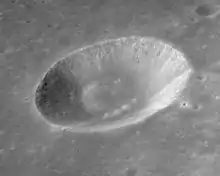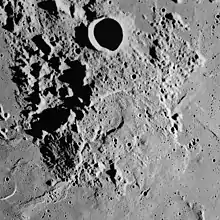Gardner (crater)
Gardner is a small lunar impact crater in the northeast part of the Moon and is named after an American physicist Irvine Clifton Gardner.[1] It lies due east of the crater Vitruvius, in a section of rough terrain north of the Mare Tranquillitatis. Gardner was previously designated Vitruvius A before being given its present name by the IAU. To the northeast of Gardner is the larger crater Maraldi.
 Apollo 17 Mapping Camera image | |
| Coordinates | 17.7°N 33.8°E |
|---|---|
| Diameter | 18 km |
| Depth | 3.0 km |
| Colongitude | 327° at sunrise |
| Eponym | Irvine C. Gardner |


It is a circular crater with sloping inner walls and an interior floor that occupies about half the total crater diameter. The southern half of the floor has a slight rise before reaching the inner wall. The crater is not significantly eroded, and the outer rim is relatively sharp and well-defined. The most distinctive feature is a row of four rounded hills along the northern floor of the crater.
To the south is an elevated area unofficially known as the Gardner Megadome.[2] In the vicinity of the dome are satellite craters including Vitruvius B, H, and T, and Maraldi D.
References
- "Gardner (crater)". Gazetteer of Planetary Nomenclature. USGS Astrogeology Research Program.
- The Lamont - Gardner Megadome Alignment: A Lunar Volcano-Tectonic Structure? Charles A. Wood, with images by Wes Higgins, KC Pau and Giorgio Mengoli, Managua Office, Planetary Science Institute, Tucson, AZ 85719. PDF
- Andersson, L. E.; Whitaker, E. A. (1982). NASA Catalogue of Lunar Nomenclature. NASA RP-1097.CS1 maint: ref=harv (link)
- Bussey, B.; Spudis, P. (2004). The Clementine Atlas of the Moon. New York: Cambridge University Press. ISBN 978-0-521-81528-4.CS1 maint: ref=harv (link)
- Cocks, Elijah E.; Cocks, Josiah C. (1995). Who's Who on the Moon: A Biographical Dictionary of Lunar Nomenclature. Tudor Publishers. ISBN 978-0-936389-27-1.CS1 maint: ref=harv (link)
- McDowell, Jonathan (July 15, 2007). "Lunar Nomenclature". Jonathan's Space Report. Retrieved 2007-10-24.CS1 maint: ref=harv (link)
- Menzel, D. H.; Minnaert, M.; Levin, B.; Dollfus, A.; Bell, B. (1971). "Report on Lunar Nomenclature by the Working Group of Commission 17 of the IAU". Space Science Reviews. 12 (2): 136–186. Bibcode:1971SSRv...12..136M. doi:10.1007/BF00171763.
- Moore, Patrick (2001). On the Moon. Sterling Publishing Co. ISBN 978-0-304-35469-6.CS1 maint: ref=harv (link)
- Price, Fred W. (1988). The Moon Observer's Handbook. Cambridge University Press. ISBN 978-0-521-33500-3.CS1 maint: ref=harv (link)
- Rükl, Antonín (1990). Atlas of the Moon. Kalmbach Books. ISBN 978-0-913135-17-4.CS1 maint: ref=harv (link)
- Webb, Rev. T. W. (1962). Celestial Objects for Common Telescopes (6th revised ed.). Dover. ISBN 978-0-486-20917-3.CS1 maint: ref=harv (link)
- Whitaker, Ewen A. (1999). Mapping and Naming the Moon. Cambridge University Press. ISBN 978-0-521-62248-6.CS1 maint: ref=harv (link)
- Wlasuk, Peter T. (2000). Observing the Moon. Springer. ISBN 978-1-85233-193-1.CS1 maint: ref=harv (link)
External links
- LTO-43D4 Vitruvius — L&PI topographic map
- Debris Flows in Gardner Crater - Lunar Reconnaissance Orbiter page with images
Related articles
- Wood, Chuck (August 16, 2004). "Megadome". Lunar Photo of the Day. Retrieved September 27, 2017. - also featuring the surrounding craters
- Wood, Chuck (September 26, 2004). "Astonishing Megadome". Lunar Photo of the Day. Retrieved August 17, 2017.
- Wood, Chuck (July 28, 2014). "Quantified Mountain". Lunar Photo of the Day. Retrieved August 17, 2017.
| Wikimedia Commons has media related to Gardner (crater). |